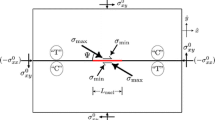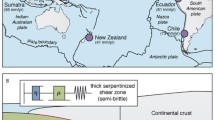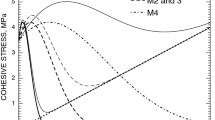Abstract
Destructive large earthquakes occur as dynamic frictional ruptures along pre-existing interfaces (or faults) in the Earth’s crust. One of the important issues in earthquake dynamics is the local duration of relative displacement or slip. Seismic inversions show that earthquakes may propagate as self-healing pulse-like ruptures, with local slip duration being much shorter than the overall rupture duration. Yet many classical models produce crack-like ruptures, with local slip durations comparable to the overall rupture duration. We study rupture modes in an experimental set up designed to mimic a fault prestressed both in compression and in shear. Our experiments demonstrate systematic variation from crack-like to pulse-like rupture modes as nondimensional shear prestress is decreased. The results of our experiments are consistent with theories of ruptures on interfaces with velocity-weakening friction. To consider the possibility that slip-weakening friction can also result in such rupture mode transition in the presence of the dynamic nucleation procedure employed by the experimental setup, we conduct numerical simulations with linear slip-weakening friction. In the simulations, we use the parameter regimes that were shown in previous studies to reproduce supershear transition distances obtained in the same experimental setup. We find that simulations with linear slip-weakening friction are unable to reproduce pulse-like ruptures, even in the presence of the dynamic initiation procedure. Our experimental results and simulations imply that velocity-weakening friction plays an important role in dynamic behavior of shear ruptures and needs to be included in earthquake models.
Similar content being viewed by others
References
Andrews DJ (1976) Rupture velocity of plane strain shear cracks. J Geophys Res 81: 5679–5687
Andrews DJ, Ben-Zion Y (1997) Wrinkle-like slip pulse on a fault between different materials. J Geophys Res 102(B1): 553–571
Archuleta RJ (1984) A faulting model for the 1979 Imperial- Valley earthquake. J Geophys Res 89(NB6): 4559–4585
Beeler NM, Tullis TE (1996) Self-healing slip pulses in dynamic rupture models due to velocity-dependent strength. Bull Seismol Soc Am 86(4): 1130–1148
Ben-Zion Y (2001) Dynamic ruptures in recent models of earthquake faults. J Mech Phys Solids 49(9): 2209–2244
Beroza GC, Mikumo T (1996) Short slip duration in dynamic rupture in the presence of heterogeneous fault properties. J Geophys Res 101(B10): 22449–22460
Cochard A, Madariaga R (1994) Dynamic faulting under rate-dependent friction. Pure Appl Geophys 142(3–4): 419–445
Cochard A, Madariaga R (1996) Complexity of seismicity due to highly rate-dependent friction. J Geophys Res 101: 25321–25336
Cochard A, Rice JR (2000) Fault rupture between dissimilar materials: ill-posedness, regularization, and slip-pulse response. J Geophys Res 105(B11): 25891–25907
Dally JW, Riley WF (1991) Experimental stress analysis. McGraw-Hill, New York
Das SM, Aki K (1977) Numerical study of 2-dimensional spontaneous rupture propagation. Geophys J Royal Astro Soc 50(3): 643–668
Day SM (1982) Three-dimensional finite difference simulation of fault dynamics: Rectangular faults with fixed rupture velocity. Bull Seismol Soc Am 72(3): 705–727
Day SM, Yu G, Wald DJ (1998) Dynamic stress changes during earthquake rupture. Bull Seismol Soc Am 88(2): 512–522
Di Toro G, Goldsby DL, Tullis TE (2004) Friction falls towards zero in quartz rock as slip velocity approaches seismic rates. Nature 427(6973): 436–439
Dieterich JH (1979) Modeling of rock friction. 1. Experimental results and constitutive equations. J Geophys Res 84(NB5): 2161–2168
Dieterich JH et al (1981) Constitutive properties of faults with simulated gouge. In: Carter NL (eds) Mechanical behavior of crustal rocks, geophysical monograph. AGU, Washington, pp 103–120
Dieterich JH (2007) Application of rate- and state-dependent friction to models of fault slip and earthquake occurence. Treatise Geophys 4: 107–129
Festa G, Vilotte JP (2006) Influence of the rupture initiation on the intersonic transition: crack-like versus pulse-like modes. Geophys Res Lett 33(15): L15320
Geubelle PH, Rice JR (1995) A spectral method for three-dimensional elastodynamic fracture problems. J Mech Phys Solids 43(11): 1791–1824
Heaton TH (1990) Evidence for and implications of self-healing pulses of slip in earthquake rupture. Phys Earth Planet In 64(1): 1–20
Ida Y (1972) Cohesive force across tip of a longitudinal-shear crack and Griffiths specific surface-energy. J Geophys Res 77(20): 3796
Johnson E (1992) The influence of the lithospheric thickness on bilateral slip. Geophys J Int 108(1): 151–160
Kanamori H, Anderson DL (1975) Theoretical basis of some empirical relations in seismology. Bull Seismol Soc Am 65(5): 1073–1095
Kostrov BV (1966) Unsteady propagation of longitudinal shear cracks. J Appl Math Mech 30(6): 1241
Lapusta N, Rice JR (2004) Earthquake sequences on rate and state faults with strong dynamic weakening. Eos Trans AGU 85(47): T22A–05
Liu Y, Lapusta N (2008) Transition of mode II cracks from sub-Rayleigh to intersonic speeds in the presence of favorable heterogeneity. J Mech Phys Solids 56(1): 25–50
Lu X, Lapusta N, Rosakis AJ (2007) Pulse-like and crack-like ruptures in experiments mimicking crustal earthquakes. Proc Natl Acad Sci USA 104: 18931–18936
Lu X, Lapusta N, Rosakis AJ (2009) Analysis of supershear transition regimes in rupture experiments: the effect of nucleation conditions and friction parameters. Geophys J Int 177(2): 717–732
Lu X, Rosakis AJ, Lapusta N (2010) Rupture modes in laboratory earthquakes: effect of fault prestress and nucleation conditions. J Geophys Res
Lykotrafitis G, Rosakis AJ, Ravichandran G (2006a) Self-healing pulse-like shear ruptures in the laboratory. Science 313(5794): 1765–1768
Lykotrafitis G, Rosakis AJ, Ravichandran G (2006b) Particle velocimetry and photoelasticity applied to the study of dynamic sliding along frictionally-held bimaterial interfaces: techniques and feasibility. Exp Mech 46(2): 205–216
Madariaga R (1976) Dynamics of an expanding circular fault. Bull Seismol Soc Am 66(3): 639–666
Madariaga R, Olsen KB (2000) Criticality of rupture dynamics in 3-D. Pure Appl Geophys 157: 1981–2001
Nielsen SB, Carlson JM, Olsen KB (2000) Influence of friction and fault geometry on earthquake rupture. J Geophys Res 105(B3): 6069–6088
Nielsen SB, Madariaga R (2003) On the self-healing fracture mode. Bull Seismol Soc Am 93(6): 2375–2388
Noda H, Dunham EM, Rice JR (2009) Earthquake ruptures with thermal weakening and the operation of major faults at low overall stress levels. J Geophys Res. doi:10.1029/2008JB006143 (in press)
Olsen KB, Madariaga R, Archuleta RJ (1997) Three-dimensional dynamic simulation of the 1992 Landers earthquake. Science 278(5339): 834–838
Perrin G, Rice JR, Zheng G (1995) Self-healing slip pulse on a frictional surface. J Mech Phys Solids 43(9): 1461–1495
Rice JR (2006) Heating and weakening of faults during earthquake slip. J Geophys Res 111: B05311
Rosakis AJ (2002) Intersonic shear cracks and fault ruptures. Adv Phys 51: 1189–1257
Rosakis AJ, Xia KW, Lykotrafitis G, Kanamori H (2007) Dynamic shear rupture in frictional interfaces: speeds, directionality and modes. In: Schubert G, Kanamori H (eds) Treatise in geophysics. Elsevier, Amsterdam
Ruina A (1983) Slip instability and state variable friction laws. J Geophys Res 88(NB12): 359–370
Samudrala O, Huang Y, Rosakis AJ (2002) Subsonic and intersonic shear rupture of weak planes with a velocity weakening cohesive zone. J Geophys Res 107(B8): 2170
Shi ZQ, Ben-Zion Y (2006) Dynamic rupture on a bimaterial interface governed by slip-weakening friction. Geophys J Int 165(2): 469–484
Shi ZQ, Ben-Zion Y, Needleman A (2008) Properties of dynamic rupture and energy partition in a solid with a frictional interface. J Mech Phys Solids 56(1): 5–24
Tsutsumi A, Shimamoto T (1997) High-velocity frictional properties of gabbro. Geophys Res Lett 24(6): 699–702
Tullis TE (2007) Friction of rock at earthquake slip rates. In: Kanamori H (ed) Treatise on geophysics, vol 4. Elsevier, Amsterdam, 131–152
Tullis TE, Goldsby DL (2003) Flash melting of crustal rocks at almost seismic slip rates. Eos Trans AGU 84(46): S51B–05
Uenishi K, Rice JR (2003) Universal nucleation length for slip-weakening rupture instability under nonuniform fault loading. J Geophys Res 108(B1):2042
Xia KW, Rosakis AJ, Kanamori H (2004) Laboratory earthquakes: the Sub-rayleigh-to-supershear rupture transition. Science 303: 1859–1861
Yuan F, Prakash V (2008a) Slip weakening in rocks and analog materials at co-seismic slip rates. J Mech Phys Sol 56: 542–560
Yuan F, Prakash V (2008b) Use of a modified torsional Kolsky bar to study frictional slip resistance in rock-analog materials at coseismic slip rates. Int J Solids Struct 45: 4247–4263
Zheng G, Rice JR (1998) Conditions under which velocity-weakening friction allows a self-healing versus a cracklike mode of rupture. Bull Seismol Soc Am 88: 1466–1483
Author information
Authors and Affiliations
Corresponding author
Rights and permissions
About this article
Cite this article
Lu, X., Lapusta, N. & Rosakis, A.J. Pulse-like and crack-like dynamic shear ruptures on frictional interfaces: experimental evidence, numerical modeling, and implications. Int J Fract 163, 27–39 (2010). https://doi.org/10.1007/s10704-010-9479-4
Received:
Accepted:
Published:
Issue Date:
DOI: https://doi.org/10.1007/s10704-010-9479-4




